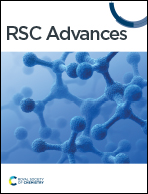Metal organic framework derived NiOx nanoparticles for application as a hole transport layer in perovskite solar cells
Abstract
NiOx as a hole transport layer (HTL) has gained a lot of research interest in perovskite solar cells (PSCs), owing to its high optical transmittance, high power conversion efficiency, wide band-gap and ease of fabrication. In this work, four different nickel based-metal organic frameworks (MOFs) using 1,3,5-benzenetricarboxylic acid (BTC), terephthalic acid (TPA), 2-aminoterephthalic acid (ATPA), and 2,5-dihydroxyterephthalic acid (DHTPA) ligands respectively, have been employed as precursors to synthesize NiOx NPs. The employment of different ligands was found to result in NiOx NPs with different structural, optical and morphological properties. The impact of calcination temperatures of the MOFs was also studied and according to field emission scanning electron microscopy (FESEM), all MOF-derived NiOx NPs exhibited lower particle size at lower calcination temperature. Upon optimization, Ni-TPA MOF derived NiOx NPs calcined at 600 °C were identified to be the best for hole transport layer application. To explore the photovoltaic performance, these NiOx NPs have been fabricated as a thin film and its structural, optical and electrical characteristics were analyzed. According to the findings, the band energy gap (Eg) of the fabricated thin film has been found to be 3.25 eV and the carrier concentration, hole mobility and resistivity were also measured to be 6.8 × 1014 cm−3; 4.7 × 1014 Ω cm and 2.0 cm2 V−1 s−1, respectively. Finally, a numerical simulation was conducted using SCAPS-1D incorporating the optical and electrical parameters from the thin film analysis. FTO/TiO2/CsPbBr3/NiOx/C has been utilized as the device configuration which recorded an efficiency of 13.9% with Voc of 1.89 V, Jsc of 11.07 mA cm−2, and FF of 66.6%.



 Please wait while we load your content...
Please wait while we load your content...